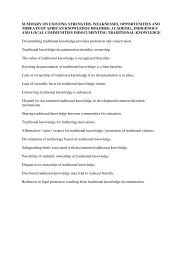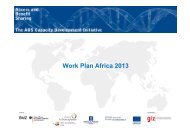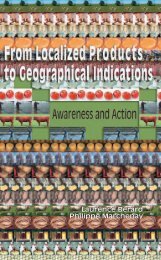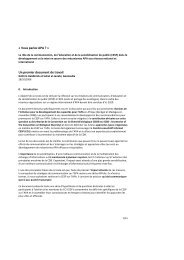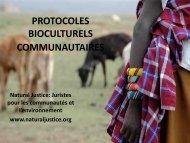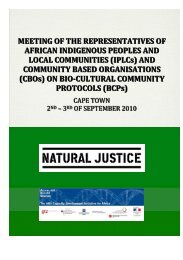The History of Farmers' Rights - Fridtjof Nansens Institutt
The History of Farmers' Rights - Fridtjof Nansens Institutt
The History of Farmers' Rights - Fridtjof Nansens Institutt
You also want an ePaper? Increase the reach of your titles
YUMPU automatically turns print PDFs into web optimized ePapers that Google loves.
v<br />
Executive Summary<br />
In 2001, the International Treaty on Plant Genetic Resources for Food<br />
and Agriculture was adopted. It entered into force on 29 June 2004. <strong>The</strong><br />
Treaty includes provisions on farmers’ rights, and explicitly states that<br />
the responsibility for implementing these provisions rests with the national<br />
governments. <strong>The</strong> latter are free to choose the measures they deem<br />
appropriate, according to their needs and priorities, but certain measures<br />
to protect and promote farmers’ rights are suggested. <strong>The</strong> preamble to the<br />
International Treaty highlights the necessity <strong>of</strong> promoting farmers’ rights<br />
at the national as well as international level. As yet, however, there is no<br />
common understanding <strong>of</strong> how this can be done. Such an understanding<br />
is <strong>of</strong> great importance for making progress in the realization <strong>of</strong> farmers’<br />
rights.<br />
<strong>The</strong> Farmers’ <strong>Rights</strong> Project has been set up to facilitate such a common<br />
understanding and develop a basis for proposals to the Governing Body<br />
<strong>of</strong> the Treaty on specific measures to be taken. <strong>The</strong> intention is to move<br />
ahead from earlier controversies, and – based on the consensus formulations<br />
in the Treaty – build bridges to a joint perception <strong>of</strong> the actions<br />
required, in respect <strong>of</strong> the countries’ freedom to choose measures according<br />
to their needs and priorities.<br />
This background study presents the findings <strong>of</strong> a survey <strong>of</strong> documentation<br />
and literature on farmers’ rights. Such a survey was considered<br />
necessary for the project in order to establish a clearer understanding <strong>of</strong><br />
the origin <strong>of</strong> the concept <strong>of</strong> farmers’ rights and its history. <strong>The</strong> intention<br />
has been to present and summarize the material and not to analyse it any<br />
further, as that would exceed the scope <strong>of</strong> this part <strong>of</strong> the project. It is<br />
hoped that this guide to the central documents and literature can be<br />
helpful to negotiators, practitioners and researchers who seek to understand<br />
the concept and the potentials <strong>of</strong> farmers’ rights.<br />
Central documents from international negotiations<br />
<strong>The</strong> idea <strong>of</strong> farmers’ rights came up in the early 1980s as a countermove<br />
to the increased demand for plant breeders’ rights, as voiced in international<br />
negotiations. <strong>The</strong> purpose was to draw attention to the unremunerated<br />
innovations <strong>of</strong> farmers that were seen as the foundation <strong>of</strong> all modern<br />
plant breeding. Thorough analysis <strong>of</strong> the documentation shows that<br />
the concept was first brought up in international negotiations in FAO in<br />
1986. Already in 1987, considerations and practical solutions were suggested<br />
that formed a foundation for all further negotiations on farmers’<br />
rights, and provided substantial input to the framing <strong>of</strong> our current understanding<br />
<strong>of</strong> the concept.<br />
In 1989, farmers’ rights were for the first time formally recognized by the<br />
FAO Conference, and in 1991 the Conference decided to set up a fund for<br />
the realization <strong>of</strong> these rights. Such a fund, however, never materialized.<br />
<strong>The</strong>n the Convention on Biological Diversity was adopted in May 1992,<br />
and with it a resolution on the interrelationship between the CBD and the<br />
promotion <strong>of</strong> sustainable agriculture. In this resolution, FAO was urged






